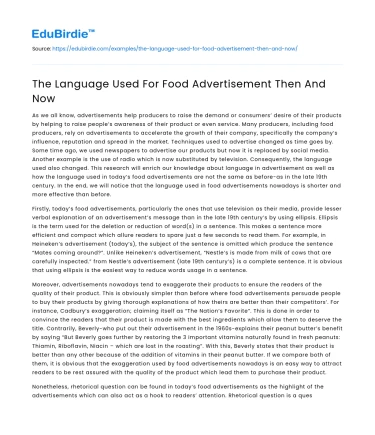As we all know, advertisements help producers to raise the demand or consumers’ desire of their products by helping to raise people’s awareness of their product or even service. Many producers, including food producers, rely on advertisements to accelerate the growth of their company, specifically the company’s influence, reputation and spread in the market. Techniques used to advertise changed as time goes by. Some time ago, we used newspapers to advertise our products but now it is replaced by social media. Another example is the use of radio which is now substituted by television. Consequently, the language used also changed. This research will enrich our knowledge about language in advertisement as well as how the language used in today’s food advertisements are not the same as before-as in the late 19th century. In the end, we will notice that the language used in food advertisements nowadays is shorter and more effective than before.
Firstly, today’s food advertisements, particularly the ones that use television as their media, provide lesser verbal explanation of an advertisement’s message than in the late 19th century’s by using ellipsis. Ellipsis is the term used for the deletion or reduction of word(s) in a sentence. This makes a sentence more efficient and compact which allure readers to spare just a few seconds to read them. For example, in Heineken’s advertisement (today’s), the subject of the sentence is omitted which produce the sentence “Mates coming around?”. Unlike Heineken’s advertisement, “Nestle’s is made from milk of cows that are carefully inspected.” from Nestle’s advertisement (late 19th century’s) is a complete sentence. It is obvious that using ellipsis is the easiest way to reduce words usage in a sentence.
Save your time!
We can take care of your essay
- Proper editing and formatting
- Free revision, title page, and bibliography
- Flexible prices and money-back guarantee
Moreover, advertisements nowadays tend to exaggerate their products to ensure the readers of the quality of their product. This is obviously simpler than before where food advertisements persuade people to buy their products by giving thorough explanations of how theirs are better than their competitors’. For instance, Cadbury‘s exaggeration; claiming itself as “The Nation’s Favorite”. This is done in order to convince the readers that their product is made with the best ingredients which allow them to deserve the title. Contrarily, Beverly-who put out their advertisement in the 1960s-explains their peanut butter’s benefit by saying “But Beverly goes further by restoring the 3 important vitamins naturally found in fresh peanuts: Thiamin, Riboflavin, Niacin – which are lost in the roasting”. With this, Beverly states that their product is better than any other because of the addition of vitamins in their peanut butter. If we compare both of them, it is obvious that the exaggeration used by food advertisements nowadays is an easy way to attract readers to be rest assured with the quality of the product which lead them to purchase their product.
Nonetheless, rhetorical question can be found in today’s food advertisements as the highlight of the advertisements which can also act as a hook to readers’ attention. Rhetorical question is a question that is asked without expecting answers. Meanwhile, food advertisements in the late 19th century frequently use imperative as the beginning of their advertisements. As an example, Snickers’ “Extra hungry?” which was the only sentence in the advertisement allured readers to look on the picture of their product. “Give your coffee a break” is an imperative sentence used by Kraft in their advertisement which was published in the 1970s. Noticeably, using a rhetorical question to begin an advertisement is an effective way to draw people’s attention to their advertisement which could also tempt the readers to buy the product advertised.
Did you like this example?
Make sure you submit a unique essay
Our writers will provide you with an essay sample written from scratch: any topic, any deadline, any instructions.
Cite this paper
-
APA
-
MLA
-
Harvard
-
Vancouver
The Language Used For Food Advertisement Then And Now.
(2022, February 21). Edubirdie. Retrieved December 21, 2024, from https://edubirdie.com/examples/the-language-used-for-food-advertisement-then-and-now/
“The Language Used For Food Advertisement Then And Now.” Edubirdie, 21 Feb. 2022, edubirdie.com/examples/the-language-used-for-food-advertisement-then-and-now/
The Language Used For Food Advertisement Then And Now. [online].
Available at: <https://edubirdie.com/examples/the-language-used-for-food-advertisement-then-and-now/> [Accessed 21 Dec. 2024].
The Language Used For Food Advertisement Then And Now [Internet]. Edubirdie.
2022 Feb 21 [cited 2024 Dec 21].
Available from: https://edubirdie.com/examples/the-language-used-for-food-advertisement-then-and-now/
copy






 Stuck on your essay?
Stuck on your essay?

